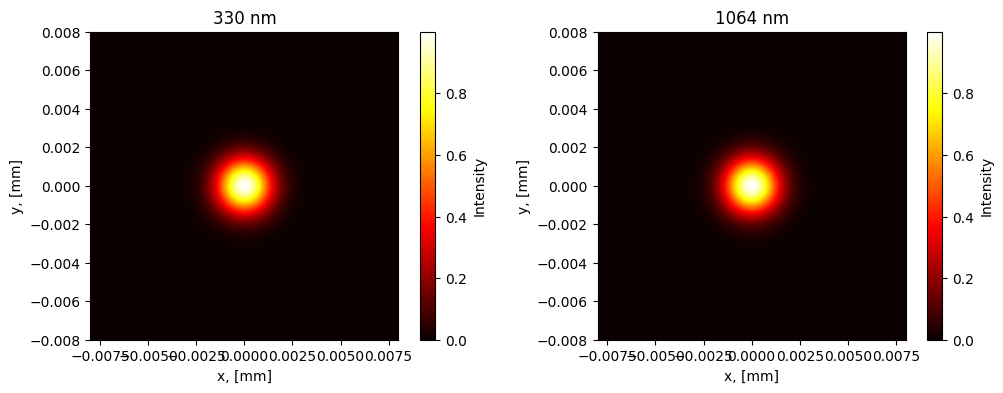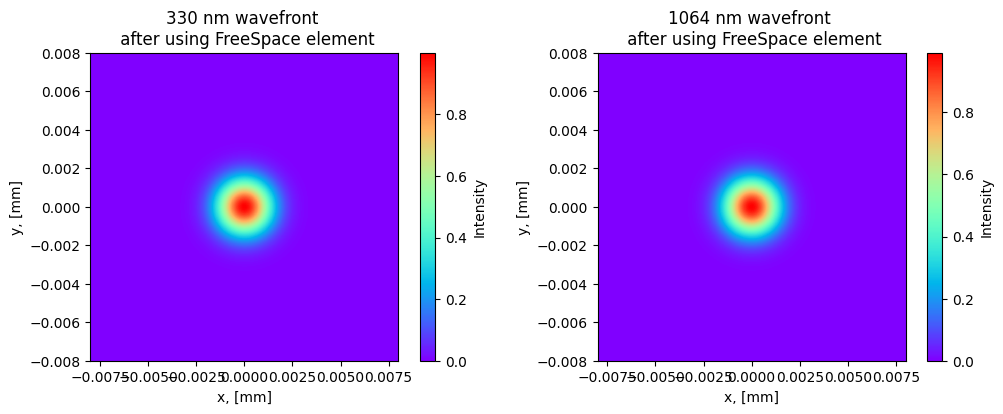[6]:
import torch
import numpy as np
import matplotlib.pyplot as plt
from svetlanna import elements
from svetlanna import SimulationParameters
from svetlanna.units import ureg
from svetlanna import wavefront as w
Gaussain Beam propagation
In this example we will use svetlanna.wavefront functional to create some wavefronts.
Firstly, it’s necessary to create the numerical mesh using SimulationParameters class. You must define your screen size \(l_x\times l_y\), number of nodes \(N_x\times N_y\) along axis and wavefront’s wavelength(group of wavelengths).
Secondly, you can use svetlanna.Wavefront.<wavefront_type> functional to create required wavefront. Available types: Gaussian beam, planar wave and spherical wave. Moreover, it’s possible to pass arbitrary torch.Tensor object that describes your specific wavefront to svetlanna.Wavefront(<torch.Tensor>).
Remark: you can create torch.tensor([wavelength1, wavelength2, ..., wavelengthN]) object and pass it to SimulationParameters if it’s necessary to propagate several wavefronts with different wavelengths.
Creating numerical mesh with using SimulationParameters class
[47]:
Nx = 1500 # number of nodes in x direction
Ny = 1500 # number of nodes in y direction
lx = 16 * ureg.mm # size of the grid in x direction
ly = 16 * ureg.mm # size of the grid in y direction
wavelength = torch.tensor([330, 1064]) * ureg.nm # wavelength of the light
# creating SimulationParameters exemplar
sim_params = SimulationParameters({
'W': torch.linspace(-lx / 2, lx / 2, Nx),
'H': torch.linspace(-ly / 2, ly / 2, Ny),
'wavelength': wavelength,
})
[48]:
# return 2d-tensors of x and y coordinates
x_grid, y_grid = sim_params.meshgrid(x_axis='W', y_axis='H')
Creating preloaded beams
Let’s create two Gaussian beams with wavelengths defined above. Both of beams will propagate along distance \(z\)
[100]:
w0 = 2 * ureg.mm # waist radius of the Gaussian Beam
z = 2 * ureg.cm # propagation distance
# return svetlanna.Wavefront class exemplar
output_field = w.Wavefront.gaussian_beam(
simulation_parameters=sim_params,
waist_radius=w0,
distance=z
)
# .intensity property of svetlanna.Wavefront class exemplar
# returns 2d-tensor which describes intensity profile of the wavefront
output_intensity = output_field.intensity
Visualize intensity profiles:
[101]:
fig, ax = plt.subplots(1, 2, figsize=(12, 4))
beam1 = ax[0].pcolormesh(x_grid.numpy(force=True), y_grid.numpy(force=True), output_intensity[0].numpy(force=True), cmap='hot')
beam2 = ax[1].pcolormesh(x_grid.numpy(force=True), y_grid.numpy(force=True), output_intensity[1].numpy(force=True), cmap='hot')
ax[0].set_title('330 nm')
ax[1].set_title('1064 nm')
ax[0].set_aspect('equal')
ax[1].set_aspect('equal')
ax[0].set_xlabel('x, [mm]')
ax[0].set_ylabel('y, [mm]')
ax[1].set_xlabel('x, [mm]')
ax[1].set_ylabel('y, [mm]')
fig.colorbar(beam1, ax=ax[0], label='Intensity')
fig.colorbar(beam2, ax=ax[1], label='Intensity')
[101]:
<matplotlib.colorbar.Colorbar at 0x14b5b5c7e90>

Arbitrary wavefront propagation
You can use svetlanna.elements.FreeSpace class to propagate arbitrary wavefront using Angular Spectrum method or Fresnel method. It’s necessary to define:
Propagation distance
Method
Input wavefront into
.forward(incident_wavefront=<svetlanna.Wavefront>)method forFreeSpaceclass
Let’s propagate our beams using Angular Spectrum method on distance \(z_0\):
[102]:
z0 = 100 * ureg.cm # propagation distance
free_space = elements.FreeSpace(
simulation_parameters=sim_params,
distance=z0,
method="AS"
)
# .forward() return svetlanna.Wavefront class exemplar
free_space_output = free_space.forward(incident_wavefront=output_field)
free_space_output_intensity = free_space_output.intensity
[103]:
fig, ax = plt.subplots(1, 2, figsize=(12, 4))
beam1 = ax[0].pcolormesh(x_grid.numpy(force=True), y_grid.numpy(force=True), free_space_output_intensity[0].numpy(force=True), cmap='rainbow')
beam2 = ax[1].pcolormesh(x_grid.numpy(force=True), y_grid.numpy(force=True), free_space_output_intensity[1].numpy(force=True), cmap='rainbow')
ax[0].set_title('330 nm wavefront \n after using FreeSpace element')
ax[1].set_title('1064 nm wavefront \n after using FreeSpace element')
ax[0].set_aspect('equal')
ax[1].set_aspect('equal')
ax[0].set_xlabel('x, [mm]')
ax[0].set_ylabel('y, [mm]')
ax[1].set_xlabel('x, [mm]')
ax[1].set_ylabel('y, [mm]')
fig.colorbar(beam1, ax=ax[0], label='Intensity')
fig.colorbar(beam2, ax=ax[1], label='Intensity')
[103]:
<matplotlib.colorbar.Colorbar at 0x14bfadf9a50>
